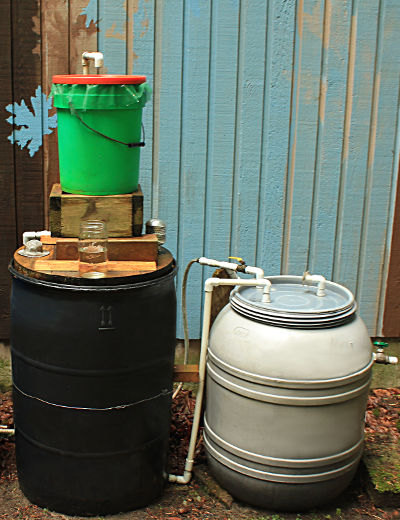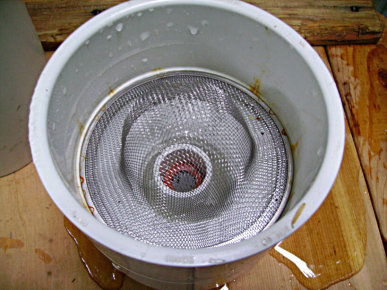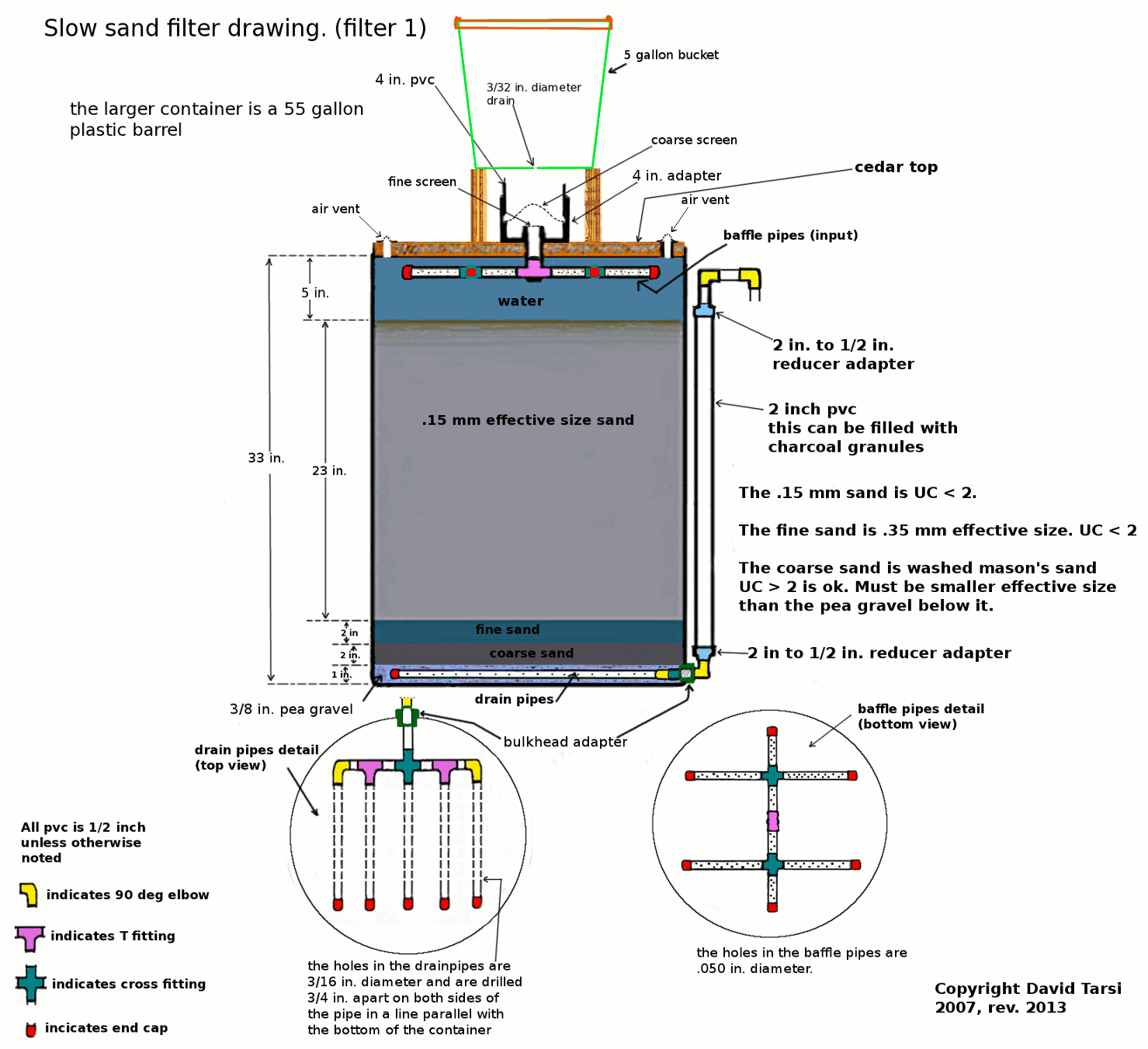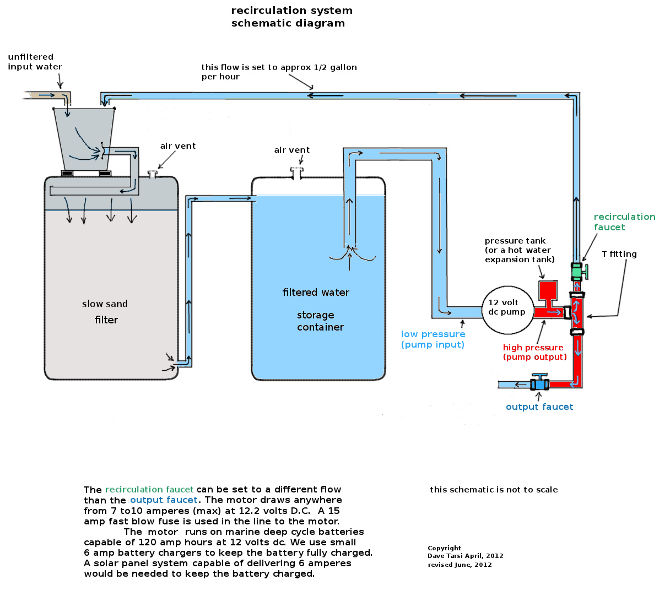|
|
|||
|
Slow sand filter in barrel as of August 2013 Still working as of March 22, 2018 (started in 2007)
This page has the most recent information on filter 1. There is a recirculation system in place. A schematic of that system is shown below. The white pipe you see at the top of the green bucket is where the recirculated water enters the filter. The water is set to 10 liters per 24 hours. This is very slight. It is enough to keep the filter alive during the dry summer months.
As of October 2, 2014 this filter (filter 1) is still in operation and producing water completely free of coliform, and e coli bacteria.A field test was done October 2 that showed no coliform or e coli present.
The grey barrel is 45 gallons of storage for filtered water. It is a recycled barrel.The black barrel is a recycled container. It is the filter we call filter 1. The top cover is cedar. It was repaired last week. Parts of the original were not cedar and had rotted. The new pieces are cedar. The jar of water on top of the black barrel is output (filtered) water from this filter as of today (August 29 2013). There is an outlet at the bottom of the barrel.
the pipe on the right side of the black barrel is the output. It no longer uses a charcoal filter.
The silver colored thing on the right is an inexpensive sprinkler head; it lets the air in and keeps the mosquitoes and other critters out. There is a screen on the left also that serves the same function, it was what I had on hand. The idea is that there must be oxygen to the surface of the water or the biofilm will die and the filter won't work. This barrel is almost full of sand and water and it is VERY heavy. When you put one of these together make sure it is where you want it and make sure where ever it is located that there is sufficient support for at least 2000 pounds in a concentrated area. You have been warned.
The top pipe is 4inch pvc fitting into a reducer adapter. You will need to slightly sand down the 4 inch pipe to be able to easily remove it to clean the screens inside. If you are careful this can be done.
The 4 inch adapter holds the large input screen (see image below) in place. The length of four inch pipe on top is now about 5 inches long and holds about pint of water. The 5 gallon bucket that a .040 in. hole drilled in the bottom. The bucket sits over the reducer adapter. There is a battery powered recirculation system in operation 24/7. This system uses very little energy and can be powered by a small solar panel combined with the battery. The recirculation flow rate is very low: between 2 and 5 gallons per 24 hour period.
The fine sand holds 50 percent water by volume when saturated. The coarse sand holds 37.5 percent water by volume when saturated. This 55 gallon barrel is filled such that there is room for approximately 21 gallons of water including the water that must be on the surface. Twenty gallons of water are in the saturated sand. This means it takes 5 hours for a complete change of water in the system if 4 gallons are added regularly over a 5 hour period. The action of water flowing through the filter is close to linear above 1 gallon of water added at a time until the water stops running out. Below that level it takes much longer for the water in the filter to be completely replaced. Adding 3/4 of a gallon at a time is the safest way to operate the filter, and still get a fairly acceptable flow rate. Using the 5 gallon bucket with the .040 inch hole drilled in the bottom allows the water to flow into the filter from the bucket at about the right speed.
This page has the most recent information on filter 1. There is a recirculation system in place. A schematic of that system is shown below. The white pipe you see at the top of the green bucket is where the recirculated water enters the filter. The water is set to 10 liters per 24 hours. This is very slight. It is enough to keep the filter alive during the dry summer months.
As of October 2, 2014 this filter (filter 1) is still in operation and producing water completely free of coliform, and e coli bacteria.A field test was done October 2 that showed no coliform or e coli present.
The grey barrel is 45 gallons of storage for filtered water. It is a recycled barrel.The black barrel is a recycled container. It is the filter we call filter 1. The top cover is cedar. It was repaired last week. Parts of the original were not cedar and had rotted. The new pieces are cedar. The jar of water on top of the black barrel is output (filtered) water from this filter as of today (August 29 2013). There is an outlet at the bottom of the barrel.
the pipe on the right side of the black barrel is the output. It no longer uses a charcoal filter.
The silver colored thing on the right is an inexpensive sprinkler head; it lets the air in and keeps the mosquitoes and other critters out. There is a screen on the left also that serves the same function, it was what I had on hand. The idea is that there must be oxygen to the surface of the water or the biofilm will die and the filter won't work. This barrel is almost full of sand and water and it is VERY heavy. When you put one of these together make sure it is where you want it and make sure where ever it is located that there is sufficient support for at least 2000 pounds in a concentrated area. You have been warned.
The top pipe is 4inch pvc fitting into a reducer adapter. You will need to slightly sand down the 4 inch pipe to be able to easily remove it to clean the screens inside. If you are careful this can be done.
The 4 inch adapter holds the large input screen (see image below) in place. The length of four inch pipe on top is now about 5 inches long and holds about pint of water. The 5 gallon bucket that a .040 in. hole drilled in the bottom. The bucket sits over the reducer adapter. There is a battery powered recirculation system in operation 24/7. This system uses very little energy and can be powered by a small solar panel combined with the battery. The recirculation flow rate is very low: between 2 and 5 gallons per 24 hour period.
The fine sand holds 50 percent water by volume when saturated. The coarse sand holds 37.5 percent water by volume when saturated. This 55 gallon barrel is filled such that there is room for approximately 21 gallons of water including the water that must be on the surface. Twenty gallons of water are in the saturated sand. This means it takes 5 hours for a complete change of water in the system if 4 gallons are added regularly over a 5 hour period. The action of water flowing through the filter is close to linear above 1 gallon of water added at a time until the water stops running out. Below that level it takes much longer for the water in the filter to be completely replaced. Adding 3/4 of a gallon at a time is the safest way to operate the filter, and still get a fairly acceptable flow rate. Using the 5 gallon bucket with the .040 inch hole drilled in the bottom allows the water to flow into the filter from the bucket at about the right speed.
 Slow sand filter August 2013  Input screen inside the 4 inch adapter |
 Slow sand filter drawing  Recirculation system schematic |
||
| back |
|
|

This work is licensed under a Creative Commons Attribution-ShareAlike 2.5 License. terms of use
